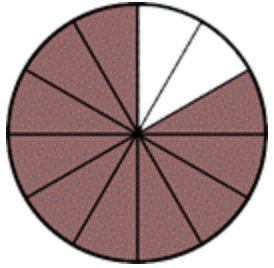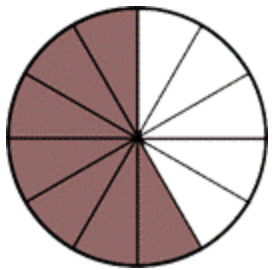10.2.3.2: Subtracting Fractions and Mixed Numbers
( \newcommand{\kernel}{\mathrm{null}\,}\)
- Subtract fractions with like and unlike denominators.
- Subtract mixed numbers without regrouping.
- Subtract mixed numbers with regrouping.
- Solve application problems that require the subtraction of fractions or mixed numbers.
Introduction
Sometimes subtraction, rather than addition, is required to solve problems that involve fractions. Suppose you are making pancakes and need
Subtracting Fractions
The most simple fraction subtraction problems are those that have two proper fractions with a common denominator. That is, each denominator is the same. The process is just as it is for addition of fractions with like denominators, except you subtract! You subtract the second numerator from the first and keep the denominator the same.
Imagine that you have a cake with equal-sized pieces. Some of the cake has already been eaten, so you have a fraction of the cake remaining. You could represent the cake pieces with the picture below.

The cake is cut into 12 equal pieces to start. Two are eaten, so the remaining cake can be represented with the fraction
If you subtract 3 pieces, you can see below that

You can solve this problem without the picture by subtracting the numerators and keeping the denominator the same:
If the denominators (bottoms) of the fractions are the same, subtract the numerators (tops) and keep the denominator the same. Remember to simplify the resulting fraction, if possible.
| Subtract. |
Solution
| Both fractions have a denominator of 7, so subtract the numerators and keep the same denominator. |
| Subtract. Simplify the answer. |
Solution
| The fractions have a like denominator, also known as a common denominator, so subtract the numerators. | |
| Simplify the fraction. |
If the denominators are not the same (they have unlike denominators), you must first rewrite the fractions with a common denominator. The least common denominator, which is the least common multiple of the denominators, is the most efficient choice, but any common denominator will do. Be sure to check your answer to be sure that it is in simplest form. You can use prime factorization to find the least common multiple (LCM), which will be the least common denominator (LCD). See the example below.
| Subtract. Simplify the answer. |
Solution
| The fractions have unlike denominators, so you need to find a common denominator. Recall that a common denominator can be found by multiplying the two denominators together. | |
|
|
Rewrite each fraction as an equivalent fraction with a denominator of 30. |
| Subtract the numerators. Simplify the answer if needed. |
The example below shows using multiples to find the least common multiple, which will be the least common denominator.
| Subtract. Simplify the answer. |
Solution
|
Multiples of 6 include 6, 12, 18, 24 Multiples of 4 include 4, 8, 12, 16, 20 |
Find the least common multiple of the denominators. |
| 12 is the least common multiple of 6 and 4. | This is the least common denominator. |
| Rewrite each fraction with a denominator of 12. | |
| Subtract the fractions. Simplify the answer if needed. |
- Answer
-
- Incorrect. Find a least common denominator and subtract; then simplify. The correct answer is
- Incorrect. Simplify the fraction. The correct answer is
- Incorrect. Subtract, don’t add, the fractions. The correct answer is
- Correct.
- Incorrect. Find a least common denominator and subtract; then simplify. The correct answer is
Subtracting Mixed Numbers
Subtracting mixed numbers works much the same way as adding mixed numbers. To subtract mixed numbers, subtract the whole number parts of the mixed numbers and then subtract the fraction parts in the mixed numbers. Finally, combine the whole number answer and the fraction answer to express the answer as a mixed number.
| Subtract. Simplify the answer and write as a mixed number. |
Solution
|
|
Subtract the whole numbers and subtract the fractions. |
| Combine the fraction and the whole number. Make sure the fraction in the mixed number is simplified. |
Sometimes it might be easier to express the mixed number as an improper fraction first and then solve. Consider the example below.
| Subtract. Simplify the answer and write as a mixed number. |
Solution
|
|
Write each mixed number as an improper fraction. |
| Since the fractions have a like denominator, subtract the numerators. | |
| Write the answer as a mixed number. Divide 11 by 3 to get 3 with a remainder of 2. |
Since addition is the inverse operation of subtraction, you can check your answer to a subtraction problem with addition. In the example above, if you add
Sometimes you have to find a common denominator in order to solve a mixed number subtraction problem.
| Subtract.Simplify the answer and write as a mixed number. |
Solution
| Recall that a common denominator can easily be found by multiplying the denominators together. | |
| Rewrite each fraction using the common denominator 6. | |
| Subtract the fractions. | |
| Subtract the whole numbers. | |
| Combine the whole number and the fraction. |
Subtract. Simplify the answer and write it as a mixed number.
- Answer
-
- Incorrect. Subtract the whole numbers, too. The correct answer is
- Correct.
- Incorrect. Subtract, don’t add, the fractions. The correct answer is
- Incorrect. Subtract the fractions as well as the whole numbers. The correct answer is
- Incorrect. Subtract the whole numbers, too. The correct answer is
Subtracting Mixed Numbers with Regrouping
Sometimes when subtracting mixed numbers, the fraction part of the second mixed number is larger than the fraction part of the first number. Consider the problem:
Now, you can write an equivalent problem to the original:
Then, you just subtract like you normally subtract mixed numbers:
So, the answer is
As with many fraction problems, you may need to find a common denominator. Remember that a key part of adding and subtracting fractions and mixed numbers is making sure to have a common denominator as a first step! In the example below, the original fractions do not have a like denominator. You need to find one before proceeding with the next steps.
| Subtract. Simplify the answer and write as a mixed number. |
Solution
|
Multiples of 5 include 5, 10, 15, 20, 25 Multiples of 4 include 4, 8, 12, 16, 20, 24 |
Find a least common denominator. 20 is the least common multiple, so use it for the least common denominator. |
| Rewrite each fraction using the common denominator. | |
| Write the expression using the mixed numbers with the like denominator. | |
| Since the second fraction part, |
|
| Rewrite the subtraction expression using the equivalent fractions. | |
| Subtract the whole numbers, subtract the fractions. | |
| Combine the whole number and the fraction. |
Sometimes a mixed number is subtracted from a whole number. In this case, you can also rewrite the whole number as a mixed number in order to perform the subtraction. You use an equivalent mixed number that has the same denominator as the fraction in the other mixed number.
| Subtract. Simplify the answer and write as a mixed number. |
Solution
| Regroup one from the whole number and write it as |
|
| Rewrite the subtraction expression using the equivalent fractions. | |
| Subtract the whole numbers, subtract the fractions. | |
| Combine the whole number and the fraction. |
If the fractional part of the mixed number being subtracted is larger than the fractional part of the mixed number from which it is being subtracted, or if a mixed number is being subtracted from a whole number, follow these steps:
- Subtract 1 from the whole number part of the mixed number being subtracted.
- Add that 1 to the fraction part to make an improper fraction. For example:
- Then, subtract as with any other mixed numbers.
Alternatively, you can change both numbers to improper fractions and then subtract.
- Answer
-
- Incorrect. This is the answer to
- Incorrect. Subtract, don’t add, the quantities. The correct answer is
- Correct.
- Incorrect. Subtract 1 from the whole number when rewriting it as a mixed number. The correct answer is
- Incorrect. This is the answer to
Subtracting Fractions and Mixed Numbers to Solve Problems
Knowing how to subtract fractions and mixed numbers is useful in a variety of situations. When reading problems, look for key words that indicate that the problem can be solved using subtraction.
Sherry loves to quilt, and she frequently buys fabric she likes when she sees it. She had purchased 5 yards of blue print fabric and decided to use
Solution
| Write an expression using subtraction to describe the situation. | |
| Rewrite the whole number as a mixed number. | |
| Subtract. Check that the mixed number is simplified. |
Sherry has
Pilar and Farouk are training for a marathon. On a recent Sunday, they both completed a run. Farouk ran
Solution
| Write an expression using subtraction to describe the situation. | |
| Rewrite the mixed numbers using the least common denominator. | |
| Since the fraction part of the second mixed number is larger than the fraction part of the first mixed number, regroup one as a fraction and rewrite the first mixed number. | |
| Write the subtraction expression in its new form. | |
| Subtract. |
Pilar ran
Mike and Jose are painting a room. Jose used
Solution
| Write an expression using subtraction to describe the situation. | |
| Rewrite the fractions using a common denominator. | |
| Subtract. Check that the fraction is simplified. |
Jose used
Mariah’s sunflower plant grew
- Answer
-
- Incorrect. Subtract, don’t add, the fractions. The correct answer is
- Incorrect. Subtract
- Incorrect. Subtract the fractions as well as the whole numbers in the mixed numbers. The correct answer is
- Correct.
- Incorrect. Subtract, don’t add, the fractions. The correct answer is
Summary
Subtracting fractions and mixed numbers combines some of the same skills as adding whole numbers and adding fractions and mixed numbers. When subtracting fractions and mixed numbers, first find a common denominator if the denominators are not alike, rewrite each fraction using the common denominator, and then subtract the numerators. When subtracting mixed numbers, if the fraction in the second mixed number is larger than the fraction in the first mixed number, rewrite the first mixed number by regrouping one whole as a fraction. Alternatively, rewrite all fractions as improper fractions and then subtract. This process is also used when subtracting a mixed number from a whole number.


